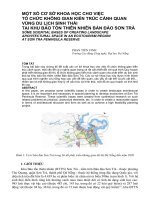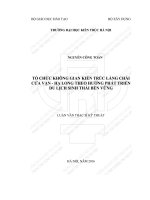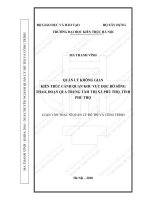Tóm tắt: Chuyển đổi không gian kiến trúc làng cổ vùng Đông Nam Bộ
Bạn đang xem bản rút gọn của tài liệu. Xem và tải ngay bản đầy đủ của tài liệu tại đây (1.02 MB, 28 trang )
MINISTRY OF CONSTRUCTION
MINISTRY OF EDUCATION AND TRAINING
NATIONAL INSTITUTE OF ARCHITECTURE
NGUYEN THANH CONG
TRANSFORMING ARCHITECTURAL SPACES OF OLD VILLAGES IN THE
SOUTHEAST REGION
Major: ARCHITECTURE
Code: 9.58.01.01
HANOI - 2023
1
THE DOCTORAL THESIS WAS COMPLETED AT
NATIONAL INSTITUTE OF ARCHITECTURE
Science instructors :
1. Dr. LE THI BICH THUAN
2. Dr. TRAN MAI ANH
The doctoral thesis is defended before the Thesis Evaluation Council
Junior doctorate at the National Institute of Architecture
At ....... hour ..... day ...... month.... year 2024
2
PREAMBLE
1. The urgency of research
The Southeast (Southeast) today is an area including 6 provinces and
cities: Ho Chi Minh City, Tay Ninh province, Binh Phuoc, Binh Duong, Dong Nai,
Ba Ria-Vung Tau, with a natural area About 23,605 km2, accounting for 7.1% of
the country's area with many advantages and resources, the Southeast region
is considered a dynamic economic development area with high growth. The
Southeast region is a region with a highly developed urban system, industrial
park and technical infrastructure transport system, demonstrating that
urbanization has developed strongly in both width and depth.
Around the year 2010, the relic management boards of provinces and
cities in the Southeast region established a project to recognize relics and
heritage, including a system of traditional villages, craft villages and 14 ancient
villages dating back from 300 to 100 years . To date, the above project has
not been approved by the government and there is no specific plan for this
system of villages. Conservation and support activities only take place
sporadically at relic sites. recognized by the Ministry of Culture.
After hundreds of years of formation and development, although it is
considered to still retain many values of architectural space and traditional
lifestyle of ancient villages in the Southeast region, in reality up to now the
values This characteristic has not been fully surveyed and evaluated, as well as
a lack of systematic research on the effects of policy - economic - social environmental transformation leading to spatial transformation in Vietnam. the
main ancient villages. Identifying the spatial values of ancient villages in the
Southeast region to adapt to the process of economic and social development
is a way to awaken a forgotten strength, avoiding an ancient village that
represents the cultural value of living in the Southeast region. The people of
the Southern region have been lost, contributing positively to the general
development of society, promoting development, creating values and
advantages to identify unique spatial characteristics, aiming at sustainable
development values. solid.
In that context, researching the topic is very necessary.
2. Research purpose
Research the transformation of ancient village architectural space to
orient the development and preservation of ancient village architectural space
in the Southeast region in accordance with the current socio-economic
development process.
3. Subject and scope of research
a. Research subjects
3
- Architectural space of ancient villages in the Southeast region.
b. Research scope
Space: Limited to provinces and cities in the Southeast region of Ho Chi
Minh City, Ba Ria Vung Tau, Binh Duong, Binh Phuoc, Dong Nai and Tay Ninh.
The scope focuses on 14 ancient villages in the Southeast region based
on the list of traditional villages and ancient villages compiled by the relic
management boards of provinces and cities in the Southeast region..
4. Research Methodology
The thesis uses the following research methods: Historical research
method ; Methods of investigation, collection and evaluation; Comparison
method;
Map overlay method;
Modeling method;
Expert methods;
Forecasting method.
5. Research content
1. Clarifying concepts and definitions related to ancient village
architectural space, researching and evaluating the current state of economic
space of ancient villages in Southeast Vietnam
2. Identify the transition process & values: Structure, landscape of
ancient villages and architectural works based on the system of criteria for
selecting ancient villages, researching the transition process combined with
survey results reality
3. Classify, select representative samples and evaluate the value of
architectural space, propose criteria to identify the level of transformation
4. Orientation for organizing ancient village architectural space to serve
economic - cultural - social development for each type of village evaluated and
classified.
5. Application of research results pilot case of Phu Hoi village.
6. New contributions of the thesis
1. Systematize theory about ancient villages in the Southeast region,
determine the architectural spatial values of ancient villages in the Southeast
region.
2. Identify the transformation of the architectural space of ancient villages
in the Southeast region during the process of socio-economic development of
the Southeast region.
3. Develop a criteria system to determine the level of transformation of
ancient villages in the Southeast region.
4. Orientation for architectural space organization for each type of ancient
village is evaluated and classified
4
5. Proposing models and solutions to organize the architectural space of Phu
Hoi ancient village in accordance with socio-economic conditions.
7. Scientific and practical significance
a. Scientific significance
- Added to the theoretical system to evaluate the current status of the
economic space of ancient villages in the Southeast region on the basis of the
rules of transformation of the economic space of ancient villages in the process
of socio-economic development.
- Research results are used in training and educational institutions on
construction architecture in the field of rural construction.
b. Practical significance
- Research results are supporting documents for management agencies
from central to local levels, organizations... in building and creating
mechanisms, policies, and regulations on the development of ancient villages
belongs to the Southeast region in the current socio-economic conditions.
- Create conditions for the community to understand the transformation of
village architectural values so that they can respond appropriately in future
development plans.
9. Some concepts
Introducing the concepts and terms used in the thesis: Village, Ancient
village,
Ancient village in the Southeast region,
Architectural space,
Architectural space Ancient village architecture, Transforming ancient village
architectural space.
5
CHAPTER 1 - OVERVIEW OF THE ARCHITECTURAL SPACE OF ANCIENT
VILLAGES IN THE SOUTHEAST REGION
1.1. Overview of formation and development of ancient villages in the
Southeast region
1.1.1. Natural condition
The Southeast region is a transitional area between the midlands and the
plains with semi-mountain terrain, high ground, including many hills, mounds,
and old forests , is a tropical monsoon area, is an alluvial plain, mostly ancient
alluvial terraces (gray soil) and red soil mountains.
The Southeast region is diverse in natural terrain, with characteristic
mountains and forests, mixed with plains, mounds, rivers, lakes, and seas.
Therefore, the types of residence here also correspond to the natural terrain
such as residing on mounds, hills, along forests, along rivers, on islands of lakes
(like Dau Tieng Lake in Tay Ninh), along the coast...
1.1.2. Residential characteristics
The rural areas of the Southeast region with a long history of formation
and diversity in population composition and origin have converged and
crystallized rich cultural - social - economic activities. There are about 36 ethnic
groups living together, united and supporting each other. Vietnamese people
make up the majority, the indigenous ethnic groups are Choro, Ma, S'tieng,
Koho... Communities came to this land at many different periods in history.
1.1.3. Characteristics of ancient village distribution in the Southeast region
Table 1. 1. Statistics on the number of communal houses/villages in the Southeast region
(source: compiled by the author)
TT
1
Province/City
Ho Chi Minh city
297 communal
houses
Dong Nai
141 communal
houses
2
Bien Hoa City
3
4
Number of
communal
houses/villages
Dating
1679-1820
Since 1802
33
Binh Duong
112 communal
houses
Ba Ria Vung Tau
Province
39 communal
houses
Ba Ria Province
36 communal
From 1820
1788-1889
6
houses
Vung Tau City
3 communal
houses
Tay Ninh
70
hamlets/villages
Trang Bang district
8 communal
houses
Binh Phuoc
6 temples
5
6
1859-1954
1850-1962
Map of village distribution in the
Southeast region
According to statistics as shown in the table above, it can be estimated
that the Southeast region has about 700 hamlets and villages that were
established before 1975. The largest number of villages is concentrated in the
midland region ( Ho Chi Minh City, Binh Duong, Dong Nai) and less in coastal
and mountainous areas.
1.1.4. Characteristics of village spatial structure in the Southeast region
Unlike the space of ancient villages in the North, the village space is
closed, confined to a campus, surrounded by bamboo fences, sometimes with
trenches, and village gates, the ancient village of Southeast Vietnam is an open
space. formed along rivers or roads that are always attached to rivers, canals
are always attached to water surfaces, have no fences, no village gates, are not
confined, the land is not fragmented, good luck.
During the process of migrating from the North to the South, Ngu Quang
people brought with them to the new settlement their ancestors' customs,
production knowledge, production practices, and a number of traditional
occupations (growing industrial crops). , shipbuilding, blacksmithing, bronze
casting, pottery, textiles, carpentry...) forming ancient villages.
The spatial transformation of ancient villages was gradually due to the
rapid increase in population and the land became narrow, so the ancient village
adapted to suit the new life. Fence gates appeared with public works such as
pillars. offices, schools, kindergartens, medical stations. Roads were opened
across many ancient villages for economic development. The old houses that
were seriously degraded have been demolished by the people themselves to
build new houses... All of this creates a much different appearance than the old
village before. Besides urbanization, there is also the construction of new rural
areas, making the space of ancient villages in Southeast Vietnam very different
from before.
1.1.5. Characteristics of village architecture in the Southeast region
7
- Traditional public architectural works : Most traditional public works in
ancient villages in the Southeast region have been restored many times. "In the
early days, due to the control of the royal court, houses and places of worship
of Southern people, even if they were very rich, were not allowed to have
tiles." Therefore, communal houses and temples are all small in scale, often
with thatched roofs. Since the 19th century, the temple was allowed to be
restored and expanded in scale. The communal houses still retain the oldest
architectural style such as Phu My communal house and An Hoa communal
house.
- Architecture of new public works: These are headquarters buildings,
schools, cultural houses and people's markets... are built but are often built
according to many different designs and spread evenly throughout the villages
and communes. However, these buildings lack the distinctive architectural style
characteristic of the region's cultural heritage . Furthermore, the rapid
development of “Cultural Villages”, “Literature Communes” culture” and
“Cultural House” have led to the mass production of buildings that have basic
functions and lack the traditional architectural elements necessary for the
cultural heritage of the region. These buildings were constructed for pure use
only and do not reflect the unique architectural style characteristic of the area.
- Housing architecture : In some villages recognized as relics, traditional
ancient houses (French - Vietnamese architectural villas, Ruong houses) are still
preserved, and the grounds have large gardens and green trees. shade in
ancient villages typical of the Southeast region.
Traditional residential
architecture in ancient villages in the Southeast has 5 forms, including: (1)
Dinh-shaped house, (2) Nhi-shaped house, (3) Three-compartment house (4)
Three-compartment house with two wings (5) House with three parallel rooms.
1.2. Overview of the development status of some ancient villages in the
Southeast region
Phu Hoi Village (Dong Nai) ; Hiep Phuoc Village (Dong Nai) ; Ba Diem
Village (Ho Chi Minh City) ; Long Dien Village (Ba Ria Vung Tau); Tan Thanh
Village (Ba Ria Vung Tau); Thanh My Village (Ba Ria Vung Tau); Long Huong
Village (Ba Ria Vung Tau); Tan Trieu Village (Dong Nai); Phu Xuan Village (Ho
Chi Minh City); Lai Thieu Village (Binh Duong); Di An Village (Binh Duong) ,
Binh Tinh Village (Tay Ninh); Gia Loc Village (Tay Ninh); Loc Thien Village
(Binh Phuoc).
1.3. Researched projects related to the thesis topic
Including: Scientific research works, books, specialized documents;
doctoral thesis; projects. C there are many research works related to ancient
architecture , history of formation and reality status development
economy - society of some ancient villages in the Southeast region. The
8
authors have compiled a lot of precious and valuable information , however,
there has not been any research on the process of transforming the
architectural space of ancient villages in the D region of NB.
1.4. The issues the thesis cares about solving
1. Recognize the spatial transformation process and the current system
of typical spatial values of the ancient village system in the Southeast region.
2. Propose methods to identify and evaluate the process of transforming
ancient village space in the Southeast region, in the process of socio-economic
development.
3. Research on the development orientation of ancient village landscape
architectural space in the Southeast region associated with socio-economic
development.
9
CHAPTER 2. SCIENTIFIC BASIS TO IDENTIFY THE SPATIAL TRANSFORMATION
PROCESS OF OLD VILLAGES IN THE SOUTHEAST REGION
2.1. Legal basis
- International: International charters and conventions on monument
conservation and restoration , International legal bases related to ancient
village architectural heritage.
- Related legal documents/state regulations : Cultural Heritage Law
No. 28/2001/QH10, Construction Law No. 50/2014/QH13, Architecture Law
No. 40/2019/QH14,
Planning Law No.: 21/2017/QH14 … and
Prime
Minister's Decisions related to the New Rural Program.
- Related project contents : provincial socio-economic planning, regional
planning Southeast region, general planning, detailed planning...
2.2. Theoretical basis
The thesis researches a number of theories related to the transformation
of ancient village architectural space , Theory of planning to renovate and
embellish villages, preserve and inherit architectural values , traditional villages;
Theory of urbanization and the trend of converting traditional villages;
2.3. Factors influencing the transformation of the architectural space of
ancient villages in the Southeast
economic and social factors
Natural environmental factors
The role of community participation
2.4. Practical basis for transforming the architectural space of ancient villages
in the Southeast region
- Practical transformation of ancient village architectural space in the
world:
Development of
ancient village space in Beijing (China),
Transformation process of 8 traditional villages Thai in Phrapradaeng district,
Samutprakarn province.
- Practices of transforming architectural space in ancient Vietnamese
villages : Preserving and converting to serve tourism activities in Duong Lam
ancient village (Hanoi), Division Phuoc Tich ancient village conservation area
(Thua Thien Hue)
- Practice of converting ancient villages in the Southeast region
Transition periods: Pre-1975 period,
period, 2006-present period.
1975-1985 period,
1986-2005
Forms of conversion: Corresponding to the natural terrain, residents of the Southeast region
often gather in the main types of (1) Forest edge residence, (2) Garden house residence, (3)
Residence on islands, (4) Residing along rivers and canals, (5) Residing along coastal areas, (6)
10
Residing on fields, hills, ancient alluvial mounds, (7) Residing around streams. Through the stages of
development, the form of residence in the above terrain features has changed.
2.5. Basis for proposing criteria for classifying the level of transformation of
ancient village architectural space in the Southeast region
- Current status of preserving ancient villages : Preserving natural
landscapes,
Preserving traditional crafts , Preserving traditional village
structures.
- New rural program
- Ability to adapt to the process of socio-economic development
11
CHAPTER 3: IDENTIFYING TRANSFORMATION TRENDS AND
ORIENTATION FOR DEVELOPMENT OF ARCHITECTURAL SPACE OF OLD
VILLAGES IN THE SOUTHEAST REGION
3.1. Perspectives and goals
Opinion
- Comply with legal regulations, development orientations of the State,
and standard regulations on planning and architecture to easily realize and
implement specifically in the future.
- Inherit and flexibly apply principles and requirements from the
International Conservation Charters on preserving village space.
- Creating flexible spaces, depending on the characteristics and functions
of each space, will have different behavioral perspectives.
Target
- Objective 1: Identify and preserve the historical characteristics of
ancient villages in Southeast Asia, including the natural environment, people
and many other functions that ancient village spaces in Southeast Vietnam
have acquired over time.
- Goal 2: Careful management and approach to heritage and unique local
values based on cultural significance, meaning aesthetic, historical, scientific,
social values or spirit to past, present and future generations.
- Goal 3: Ensure participation and symbiosis of cultural values, social
forms, old and new economic types are developed harmoniously.
3.2. Rule
Principles for transforming component spaces
(1) For heritage space: preserve and promote cultural heritage and
natural heritage without being framed but in the direction of "open
space" but based on methods of organizing the transformation of
heritage space to adapt to the actual needs of people and the general
development orientation of the locality.
(2) For old space: renovate the degraded old space, create buffer space
to protect the heritage area. The potential for developing the buffer
space of ancient villages in Southeast Vietnam is largely feasible due to
the large amount of public land and green land.
(3) For expanded space: add new spaces suitable for contemporary
lifestyle (including living and production) and new rural orientation in
addition to preserving traditional values such as: activities, lifestyle and
12
production. In expanded spaces, modern infrastructure is integrated to
ensure a healthy living environment and sustainable development in the
future.
(4) For newly planted spaces within the old village: public works, People's
Committee, information station... when built or renovated must be
suitable and compatible with the village spatial language.
3.3. Identifying the trend of transforming ancient village economic spaces in
the Southeast region
3.3.1. Building a criteria system to classify the level of spatial transformation
of ancient village architecture in the Southeast region
The degree of spatial transformation can be divided into 3 main types:
(i) Type 1: Almost intact
(ii) Type 2: Partial conversion
(iii) Type 3: Complete transformation
Table 3. 1. Criteria for classifying the degree of transformation of ancient village architectural
space
Criteria
1
2
3
4
5
Characteristics and properties
Traditional job
Endemic natural
landscape
Traditional
village spatial
structure
Traditional
public works
(religious,
public...)
Traditional
housing
- Traditional occupations are still preserved alongside many
new livelihoods that appear following the process of
urbanization
- Old traditional occupations are no longer maintained, or
traditional occupations have transformed into complete
industrialization
- There is a mixture of transformation, however the main
characteristics of the rural landscape (cultivated area, terrain
characteristics...) still exist.
- The village landscape has transformed towards urbanization,
with no or very few rural and agricultural landscape
characteristics remaining.
- The traditional traffic structure is still maintained, but
developed in new areas.
- The old road and village traffic system has changed
fundamentally
- New functional spaces appear interwoven with old functions
- Many new functional areas appear and replace most
traditional functional areas
Conversion
points(100)
20
0
25
0
25
20
10
0
- Traditional public works still remain, in addition, many new
functional public works and spaces are built interspersed.
20
- Traditional public works have completely changed in form
- Traditional public spaces have completely disappeared, new
urban public spaces have appeared
- Housing still retains its traditional style, with little change,
and no new forms of residence appear.
- New houses appear, or converted from old houses, while
10
0
10
5
13
traditional houses still exist and are renovated.
- The houses have changed in structure and form
0
Table 3. 2. Classification of conversion types based on criteria assessment scores
Type 1: Almost intact
Conversion points
80-100
Type 2: Partial
conversion
50-80
Type 3: Complete
transformation
0-50
Based on these factors, the transformation of spatial types in 14 ancient
villages in the Southeast will be classified to provide directions for development
intervention. For example, the areas with slow changes in both economy and
society are the villages located in the West of the Southeast region, which are
the villages of Binh Tinh, Gia Loc (in Tay Ninh) and Cong Tra Loc Thien village (in
Tay Ninh). in Binh Phuoc). These villages will be classified into type 1: Almost
intact. As for Lai Thieu villages (Thuan An City, Binh Duong), Di An villages (Di
Anh City, Binh Duong) have strong local development thanks to traditional
pottery activities and other services, close spatial structure. as having
completely changed from tradition, will be classified as type 3.
3.3.2. Identify trends in spatial structure transformation
- Transforming the spatial structure of garden house villages: Villages
with garden houses often have the advantage of geographical location: located
on flat ground and with convenient road traffic, so the majority The old garden
house villages in the Southeast region are all affected by the process of
industrialization and modernization.
- Transforming the spatial structure of villages along rivers and canals:
Villages along rivers and canals have advantages in both road and waterway
traffic, so in addition to agricultural activities, handicraft industries (so villages
along rivers and canals are often craft villages), commercial activities also take
place from the stage of village formation. Up to now, the process of economic
and social development, modernization and urbanization has negatively
impacted the gradual loss of architectural, landscape and traditional cultural
heritage values of ancient villages. The village road system is concreted,
architectural works use haphazard construction materials and lack of
investment and research, making the image of the villages become dry and
lacking identity.
- Transformation of the spatial structure of villages residing on islands:
Villages residing on islands are located in the expansion area of urban centers,
therefore, the process of
urbanization metabolism takes place quickly.
Agricultural and handicraft activities tend to disappear, replaced by activities
providing services to urban areas, while the process of on-site urbanization
takes place.
- Transforming the spatial structure of villages along the edge of the
14
forest:
With villages along the edge of the forest, the current natural
landscape in the entire area retains many wild features, so the image of the
villages is The rural village still maintains its sharpness.
3.3.3. Identifying transformation of traditional residential architectural works
- Transformation of campus and landscape
- Conversion to premises
- Transformation in architectural form
3.4. Proposed spatial structure of ancient villages in the Southeast region
Division of ancient village spaces in the Southeast region
- Heritage protection and promotion area
- Heritage area
- Connection space
- The reserve space grows
Diagram to protect ancient village space
3.4.1. The village structure is in the form of renovating, embellishing and
expanding the ancient village
- The village completely transformed
+ The overall spatial structure has changed a lot and there has been a
strong transformation based on expanding scale and increasing construction
density.
+ The natural landscape is narrowed and the relationship between
architecture and space is broken
+ In the process of development planning with large-scale projects:
industrial - export processing zones, urban areas, functional areas and new
residential areas.
15
Current Status
Solution: Conservation in spots or small areas
- The ancient village has partly changed
+ Traditional production space has shrunk, traditional infrastructure and green spaces are
still preserved, traditional public works and housing are well preserved.
+ New public works and urban infrastructure appear within the ancient
village.
Current Status
Solution: Form cohesive communities
3.4.2. Village structure preserves and promotes values
- The ancient village is almost intact
+ The overall structure and traditional public works are still intact
+ New public works and urban infrastructure appear within the ancient
village.
16
Current Status
Solution: Total conservation
3.5. Proposal to preserve and develop ancient village architecture in the
Southeast region
3.5.1. Orientation to preserve and develop traditional religious and belief
architecture
Preserve the location of religious architectural works and
traditional beliefs
- Preserve the landscape of traditional religious and belief structures
-
Preserve and develop traditional religious and religious architectural
works
I- Heritage area
1. Main works
2. Yard3. Gate
4, 5. Open yard
6. Additional works
II- Heritage protection area
III- Connection space
3.5.2. Orientation to preserve and develop traditional housing architecture
a) General requirements
- Preserving traditional architectural culture through preserving
17
architectural forms and spatial organization solutions of houses in the
Southeast region.
- Can be combined with other activities without affecting the landscape
or main works: handicrafts, agricultural drying grounds, trade - services...
- Meet the need for future development and expansion of living space or
have alternative solutions
- Ensure technical infrastructure conditions meet the needs of people's
comfort, have measures to treat domestic wastewater and
agricultural/handicraft waste to protect the environment.
- Solve the micro-climate conditions of the house well, increase
ventilation and natural lighting.
b) Overall site design solution
- Solution for the most combination of fonts
- Solution for combining double and nail styles
- Solution for combining subject fonts
18
3.5.3. Orientation for new architectural development
- Architecture of new public works:
(1) Public works (2) Social
infrastructure works (3) commercial - service works.
- Newly built housing architecture: (1) garden house (2) housing
combined with handicraft production, (3) housing combined with trading and
commercial services .
3.6. Case study of Phu Hoi village
3.6.1. History of Phu Hoi village development
From 1975 to present: Phu Hoi village's official name is Phu Hoi
commune with a natural area of 1918.86 hectares, length from North to South
approximately 4.13km, from East to West approximately 3.71 km .
In the history of the development of Phu Hoi village's architectural space,
the current appearance of the village is most influenced by planning projects,
including:
- 2006: Adjusted the general planning of Nhon Trach new urban area,
Dong Nai province (Approved by Dong Nai Provincial People's Committee)
- 2007: General planning for construction of Phu Hoi commune - Nhon
Trach district - Dong Nai province. (Approved by Dong Nai Provincial People's
Committee)
- 2014: Construction planning for Dong Nai province until 2020, vision to
2050
- 2021: Land use planning until 2030 in Nhon Trach district.
In particular, the Phu Hoi Commune Construction Master Plan project in
2007 restructured the space and changed the occupational structure of the
village.
3.6.2. Current status of architectural space in Phu Hoi ancient village
a. Architectural spatial structure of Phu Hoi ancient village
19
Developers on both sides of traffic routes
Housing developments are clustered in clusters
Concentrated residential area
River habitat
Current residential landscape : The landscape of Phu Hoi today is a
rural area with a total of rivers, canals, farmland, slope land, residential land
(houses, garden land) and farmland.
The organization of Phu Hoi village has the following characteristics (i)
component spatial elements such as: agricultural production space, residential
space distributed separately; (ii) The village center is the place where power is
concentrated, as well as the place where community activities are organized;
(iii) there are no village gates or village bamboo poles to maintain order and
protect the village; (iv) Open traffic structure, easy to access (v) rich and diverse
hydrological system, serving daily life and farming agriculture (large and small
scale) (vi) Activities Trading activities (markets) take place in places where
people in other areas can interact (vii) The structure of residential units is
diverse.
b. Traffic
The traditional road traffic characteristics of Phu Hoi ancient village are
that the internal roads are all based on semi-mountainous terrain and the
ditch system for small and medium sized fruit orchards, so they do not
follow straight routes. like in the delta villages. The scale and finishing
materials of these internal roads are diverse, on average the roads are about
3-4m wide, made of soil, brick or asphalt. It can be said that the narrow,
winding internal roads along with the intricate ditch system and fruit
gardens surrounding the housing projects have created a unique and
attractive landscape for Phu Hoi ancient village.
Phu Hoi village today still retains its old road structure quite intact with
two main roads - a vertical road through the village (now Road 25A) and a
central road connecting the village with a large-scale industrial park. big; and
the internal road system accessing residential clusters and traditional public
buildings of the village.
c. Characteristics of architectural works
New social infrastructure projects are also focused on construction,
especially after the launch of the New Rural Policy. The committee
headquarters, preschool, primary school, medical station... are located on the
main road and have a scale suitable to the current population size of Phu Hoi
village.
Traditional public buildings basically retain their original shape and are









